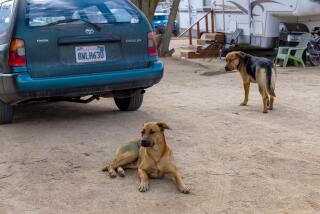Midwest going hog wild; ranchers aren’t rooting
- Share via
NEWTON, Kan. — The nicknames tell much of the story.
Vermin. Walking garbage disposals. Or 250-pound rats.
That’s what Kansas ranchers call wild hogs--when they’re feeling polite.
Mean and hairy, with nasty tusks and vicious tempers, wild hogs are most emphatically not welcome here in farm country. They tear up ground crops, churn through riverbeds, drive out native species and threaten to spread disease to pig and man alike.
But they do have one group of very loyal fans: hunters.
Hunters have a different nickname for the feral hogs. They call them the “poor man’s grizzly bear” because hunting them is a cheap but enduring thrill. They’re fierce and smart; they’re sneaky and they can run. And once you finally nab one, well, they’re darn good eating--and lots of it too. Some folks even hunt the big black boars as trophies, to hang on their walls or brag about to their buddies down at the coffee shop.
In fact, hunters like wild hogs so much, Kansas officials suspect they’re sneaking the critters into the state and releasing them, illegally, to be tracked down later for the sport of it.
“They probably come here [from Texas or Oklahoma] in someone’s trailer in the dead of night,” said Bill Hlavachick, a retired biologist for the Kansas Department of Wildlife and Parks. “And once they’ve got a toehold here, it’s pretty hard to get rid of them.”
Indeed, feral hogs reproduce so quickly that hunters cannot possibly keep them in check, although Kansas has declared open season on the great tusked beasts year-round. They’re so adaptable that they thrive in just about any environment, from a briar patch to a swamp to a forest. And they scarf down just about any food, from beetles to bird eggs to wildflowers to salamanders, baby goats and garbage.
Plus, once they reach about 6 months old (and weigh in at 40 to 50 pounds), feral hogs have no natural predators. Coyotes can’t catch them, neither can bobcats. So it’s extremely tough to clear them from an area, as Texas--with an estimated population of 1.5 million hogs--knows from bitter experience. “You’re not going to wipe ‘em out,” said Rick Taylor, a biologist for Texas Parks and Wildlife. “It’s just impossible.”
Aided, perhaps, by hunters eager for tasty new game, the pesky porkers have extended their range dramatically in the last few years. They’ve invaded Colorado, Illinois, Indiana and Ohio as well as Kansas; they now claim the entire southern half of the U.S. as their territory. They’ve torn up farmland and national parks, even golf courses and seashores, in at least 23 states, including California.
“Here we are looking at the year 2000 and there’s this great big animal expanding its range rapidly to the north,” said Philip Gipson, a biology professor at Kansas State University who studies feral hogs. “It’s all very exciting. But it can also be quite alarming to agricultural producers and to folks concerned with endangered animals and plants.”
Just glance at a photo of wild hogs rooting and the source of that alarm is abundantly clear.
Ever ravenous, the pigs can work through a field of grain in a night or two, ripping up the topsoil and digging mini-ditches that can trip up tractors and injure unsuspecting farmers. “Each one of these hogs is a rototiller waiting to happen,” says Michael Pearce, an outdoors writer from this small town in central Kansas.
In forests, they can eat so many acorns and berries that they effectively starve out other animals. They’ve been known as well to munch on endangered plants and suck the eggs of ground-nesting birds. On California’s Channel Islands, in fact, feral hogs so devastated native species and Chumash Indian burial grounds that the National Park Service has paid professional hunters to eradicate them--if possible.
So far, Kansas officials have spotted three main herds of feral pigs. One roams the Gyp Hills in south-central Kansas, another claims territory in the southeast, and a third is settling into a heavy artillery range at Ft. Riley, rooting happily among unexploded shells. The Army tried to get rid of the Ft. Riley herd last year by sending a hunter over the range in a helicopter. And although he downed 199 hogs, several dozen escaped--enough to keep breeding and building up the population.
Scoffing at the fear these three herds have generated, some biologists insist that wild pigs are not about to overrun Kansas. Unlike Texas, Kansas does not have much thick ground cover; the pigs are unlikely to settle permanently in open prairie, environmental scientist Terry Clarkson said.
“There’s a lot of speculation that these animals are going to bring terror to any territory they move into,” Clarkson said. “But I just don’t see that they’re going to be that much of a problem here.”
Then again, Clarkson, who works for the Kansas Department of Agriculture, has seen the hogs up close. He knows how cagey they can be. And so he won’t write them off altogether. “I don’t want to say that [they won’t pose a problem] as the gospel truth,” he said. “You can always get fooled.”
More to Read
Sign up for Essential California
The most important California stories and recommendations in your inbox every morning.
You may occasionally receive promotional content from the Los Angeles Times.













